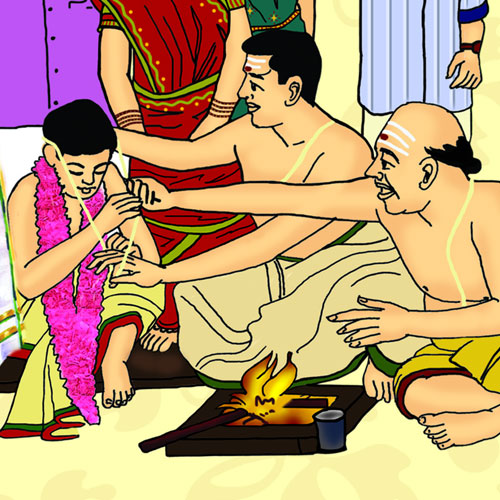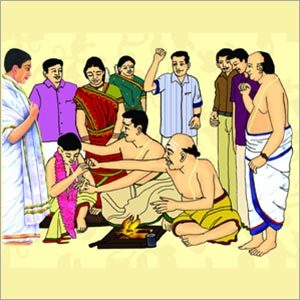
Upanayana Sanskar

Upanayana means “taking to Acharya”. In other words,”to prepare the new disciple to acquire knowledge”.
This is a very important sanskar among all the sanskars. “Its origin is Indian and Iranian.
Upanayana is a ritual which is performed for one who wants to attain knowledge. This ritual is done by reciting Gayatri Mantra.
A person seeking knowledge would go to the Guru with a piece of wood (Samidha) in his hand and request him to take him as a disciple. The Guru would ask him to offer the Samidha in the fire. Symbolically, this is the immersion of his ego in the fire.
According to the Vedas, the period for studying one Veda was 12 years and for four Vedas it was 48 years. The father also taught the son and generally the student went to the Guru's house and stayed with him to acquire knowledge.
According to the Ashvalayana Griha Sutra, the Upanayana of a Brahmin took place in the 8th year, that of a Kshatriya in the 11th year and that of a Vaishya in the 12th year. This age is given differently in different texts.
A celibate used to wear two clothes. Uttariya was worn on top and Vasas (Dhoti) below. The undergarment was of red color for Brahmin, madder colored for Kshatriya and turmeric colored undergarment for Vaishya. As Uttariya, clothes made of sheep, deer skin or cotton were worn. They wear Yagyopavit, belt and stick (Dand).
Dand is a symbol of protection of the scriptures. It is a pledge of the student that he will protect the knowledge & tradition.
The belt was tied on the underwear which was different for different castes.
Students wear the string of sutras, cloth or kush rope in the form of sacrificial fire.
There are three sutras in Yajnopavita, but one sutra has nine threads.
Deval has written the names of nine gods of nine Tantu – they are Omkar, Agni, Naga, Som, Pitar, Prajapati, Vayu, Surya and Vishvedev.
A celibate wears one and a householder wears two Yagyopavits.
We also find evidence of women's Upanayana in Smritis. Brahmavadinis used to wear Yajnopaveet.
Yama has written that in ancient times, women also had a rule to wear the sacred thread made of Moonj and they used to study the Vedas. Her student life ended when she started menstruating.
It was mandatory for the student to keep Shikha and do alms. The three sutras of Yajnopavita are symbols of Vedatrayee.









